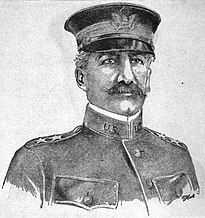George Windle Read
| George Windle Read | |
|---|---|
 |
|
| Born | November 19, 1860 Indianola, Iowa, United States |
| Died | November 6, 1934 Washington, D.C., United States |
| Buried at | Arlington National Cemetery, Arlington, Virginia, United States |
| Allegiance |
|
| Service/branch |
|
| Years of service | 1883–1925 |
| Rank |
|
| Unit |
|
| Commands held |
152nd Depot Brigade 77th Infantry Division 15th Cavalry Division 30th Infantry Division II Corps American Embarkation Center, Le Havre, France 42nd Infantry Division V Corps Philippine Department |
| Battles/wars |
Spanish–American War Pancho Villa Expedition World War I |
| Awards | Army Distinguished Service Medal |
Major General George Windle Read (November 19, 1860 – November 6, 1934) was a senior United States Army officer who was prominent as a corps and division commander in World War I. Read also oversaw the departure of US forces from Europe at the end of the war as commander of the American Embarkation Center at Le Havre, France.
Read was born in Indianola, Iowa. He graduated from the United States Military Academy in 1883 and was commissioned as a Second Lieutenant of Infantry.
Read's initial assignments were in the American West, and his first posting was with the 16th Infantry Regiment. A few months later he transferred to the 5th Cavalry Regiment, with which he served until 1889.
From 1889 to 1893 Read was Assistant Professor of Military Science at the University of Iowa, after which he returned to the 5th Cavalry Regiment in Texas.
In 1898 Read authored The Automatic Instructor: A Practical System for Home Study.
At the start of the Spanish–American War Read was assigned to an Ordnance unit, with which he served in Cuba until 1899. Receiving promotion to Captain, he served in New Mexico from 1901 to 1902, after which he was assigned to the Philippines.
...
Wikipedia
